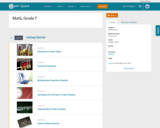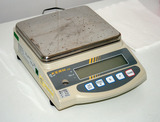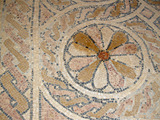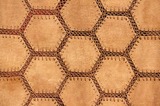
- Subject:
- Mathematics
- Material Type:
- Full Course
- Provider:
- Pearson
- Date Added:
- 02/28/2022


Algebraic Reasoning
Type of Unit: Concept
Prior Knowledge
Students should be able to:
Add, subtract, multiply, and divide rational numbers.
Evaluate expressions for a value of a variable.
Use the distributive property to generate equivalent expressions including combining like terms.
Understand solving an equation or inequality as a process of answering a question: which values from a specified set, if any, make the equation or inequality true?
Write and solve equations of the form x+p=q and px=q for cases in which p, q, and x are non-negative rational numbers.
Understand and graph solutions to inequalities x<c or x>c.
Use equations, tables, and graphs to represent the relationship between two variables.
Relate fractions, decimals, and percents.
Solve percent problems included those involving percent of increase or percent of decrease.
Lesson Flow
This unit covers all of the Common Core State Standards for Expressions and Equations in Grade 7. Students extend what they learned in Grade 6 about evaluating expressions and using properties to write equivalent expressions. They write, evaluate, and simplify expressions that now contain both positive and negative rational numbers. They write algebraic expressions for problem situations and discuss how different equivalent expressions can be used to represent different ways of solving the same problem. They make connections between various forms of rational numbers. Students apply what they learned in Grade 6 about solving equations such as x+2=6 or 3x=12 to solving equations such as 3x+6=12 and 3(x−2)=12. Students solve these equations using formal algebraic methods. The numbers in these equations can now be rational numbers. They use estimation and mental math to estimate solutions. They learn how solving linear inequalities differs from solving linear equations and then they solve and graph linear inequalities such as −3x+4<12. Students use inequalities to solve real-world problems, solving the problem first by arithmetic and then by writing and solving an inequality. They see that the solution of the algebraic inequality may differ from the solution to the problem.

Students use algebraic expressions and equations to represent rules of thumb involving measurement. They use properties of operations and the relationships between fractions, decimals, and percents to write equivalent expressions.Key ConceptsExpressions and equations are different. An expression is a number, a variable, or a combination of numbers and variables. Some examples of expressions are:74x5a + b3(2m + 1)In Grade 7, the focus is on linear expressions. A linear expression is a sum of terms that are either rational numbers or a rational number times a variable (with an exponent of either 0 or 1). If an expression contains a variable, it is called an algebraic expression. To evaluate an expression, each variable is replaced with a given value.Equivalent expressions are expressions for which a given value can be substituted for each variable and the value of the expressions are the same.An equation is a statement that two expressions are equal. An equation can be true or false. To solve an equation, students find the value of the variable that makes the equation true.Students solve an equation that involves finding 10% of a number. They see that finding 10% of the number is the same as finding 0.1 of the number, or finding 110 of the number.Goals and Learning ObjectivesWrite expressions and equations to represent real-world situations.Evaluate expressions for given values of a variable.Use properties of operations to write equivalent expressions.Solve one-step equations.Check the solution to an equation.

Students explore the effects of wind on a plane's time and distance and represent these situations using algebraic expressions and equations. They use terms with positive, negative, and zero coefficients.Key ConceptsIn this lesson, students show what they remember from Grade 6 about writing expressions and solving one-step equations. They use what they learned earlier in Grade 7 about adding and subtracting integers. They extend these concepts to write and interpret an expression with a negative coefficient.Goals and Learning ObjectivesReview addition and subtraction of integers.Review the relationship between distance, time, and speed.Write an algebraic expression for distance in terms of time, t.Write a term with a negative coefficient.Review solving a one-step equation using the multiplication property of equality.

Students write and solve inequalities in order to solve two problems. One of the problems is a real-world problem that involves selling a house and paying the real estate agent a commission. The second problem involves the relationship of the lengths of the sides of a triangle.Key ConceptsIn this lesson, students again use algebraic inequalities to solve word problems, including real-world situations. Students represent a quantity with a variable, write an inequality to solve the problem, use the properties of inequality to solve the inequality, express the solution in words, and make sure that the solution makes sense.Students explore the relationships of the lengths of the sides of a triangle. They apply the knowledge that the sum of the lengths of any two sides of a triangle must be greater than the length of the third side to solve for the lengths of sides of a triangle using inequalities. They solve the inequality for the length of the third side.Goals and Learning ObjectivesUse an algebraic inequality to solve problems, including real-world problems.Use the properties of inequalities to solve an inequality.

Gallery OverviewAllow students who have a clear understanding of the content thus far in the unit to work on Gallery problems of their choosing. You can then use this time to provide additional help to students who need review of the unit's concepts or to assist students who may have fallen behind on work.Gallery DescriptionsMatch InequalitiesStudents match inequalities to their solutions.Product Between One-Half and OneStudents find a range of values for an inequality situation.Inequalities about NumbersStudents write inequalities to solve problems about the sums of three consecutive numbers.School DanceStudents use equations and an inequality to model the costs and revenues of holding a school dance.What Could My Number Be?Students use inequalities to identify possibilities for a number given certain conditions.Batting AverageStudents use an inequality to find the number of hits needed to get a desired batting average.

Gallery OverviewAllow students who have a clear understanding of the content thus far in the unit to work on Gallery problems of their choosing. You can then use this time to provide additional help to students who need review of the unit's concepts or to assist students who may have fallen behind on work.Gallery DescriptionsFlight of the AlbatrossStudents use estimation to learn about the distances albatrosses fly.SalesStudents use equivalent expressions to solve two-step percent of increase or percent of decrease problems in one step.Carpet CleaningStudents write and solve equations to model the relationship between hours worked and the cost of carpet cleaning.Equations About NumbersStudents write an equation to solve a problem about the sum of three consecutive numbers. Then they write and solve their own problem about the sum of three consecutive numbers.Equations About SportsStudents write and solve equations to solve problems about a basketball game and about walking versus bicycling.Equations About FiguresStudents write and solve equations to model the side lengths and areas of rectangles.A Number TrickStudents use what they know about simplifying algebraic expressions to do number tricks.

Students write expressions for geometric situations. They examine how different equivalent expressions can show different ways of thinking about the same problem.Key ConceptsStudents use their previous knowledge of how to find the perimeter and area of squares and rectangles. They write algebraic expressions for the perimeter and area of geometric figures. They examine how equivalent expressions, used to represent a problem situation, give clues to the approach the writer of the expression used to solve the problem. In the Challenge Problem, they use the distributive property to find the solution.ELL: For ELLs, access prior knowledge by writing the words area and perimeter on the board. Have students create concept maps associated with area and perimeter. Record students' responses on large poster paper that you can display in the room. The goal is to generate a list of words that students can use as a reference.Goals and Learning ObjectivesAccess prior knowledge of how to find the perimeter and area of squares and rectangles.Write algebraic expressions for finding perimeter or area of figures.Identify equivalent expressions.

Students use inequalities to solve real-world problems. They see that the solution of the algebraic inequality may differ from the solution to the problem it represents. For example, a fractional number or a negative number may not be an appropriate solution for a word problem.Students complete a Self Check. They are given an algebraic inequality that they need to solve. They then write and solve a word problem that the inequality could represent.Key ConceptsIn this lesson, students write and solve an algebraic inequality that matches a situation given in a word problem. They then interpret that algebraic solution in the context of the problem. For example, students write and solve an algebraic inequality to represent the number of T-shirts that can be bought given a certain amount of money and another purchase. The inequality produces the solution t < 2.5. Since a fractional part of a T-shirt does not make sense, students reason that 2 is the greatest number of T-shirts that can be purchased.Goals and Learning ObjectivesInterpret the solution to an algebraic inequality within the context of a word problem.

Students match equations such as 3x − 50 = 90 and 3(x − 50) = 90 to real-world and mathematical situations. They identify the steps needed to solve these equations.Key ConceptsStudents solve equations such as 3x − 50 = 90 by using first the addition property and then the multiplication property of equality.Students also solve equations such as 3(x − 50) = 90. Equations with parentheses were introduced in the Challenge Problem of Lesson 6. Now, in this lesson, students use two methods to solve the equation. First method: use the multiplication property of equality and then the addition property of equality; second method: use the distributive property to eliminate the parentheses, then use the addition property of equality, and then the multiplication property of equality.Goals and Learning ObjectivesMatch equations to problems.Solve two-step equations.

Students work with a partner to revise their work on the Self Check. Students work with their partner to do activities that involve using expressions and equations to solve problems.Key ConceptsStudents will use what they have learned so far in this unit about writing expressions as well as writing and using equations to solve problems.Goals and Learning ObjectivesUse expressions and equations to solve problems.

Students solve real-world problems by writing and solving equations. Students estimate the solution and determine if the estimate is reasonable before finding the exact solution. They write the solution as a complete sentence.Students complete a Self Check.Key ConceptsStudents solve real-world problems by first estimating the solution and assessing the reasonableness of the solution. Next, they write an equation to solve the problem and then use the properties of equality to solve the equation. Students write the solution to the problem as a complete sentence.Goals and Learning ObjectivesWrite equations to solve multi-step real-life problems involving rational numbers.Solve equations using addition, subtraction, multiplication, and division of rational numbers.Use estimations strategies to estimate the solution and determine if the estimate is reasonable.Write the solution as a complete sentence.

Students work in pairs to critique and improve their work on the Self Check. Students complete a task similar to the Self Check with a partner.Key ConceptsTo critique and improve the task from the Self Check and to complete a similar task with a partner, students use what they know about solving inequalities, graphing their solutions, and relating the inequalities to a real-world situation.Goals and Learning ObjectivesSolve algebraic inequalities.Graph the solutions of inequalities using number lines.Write word problems that match algebraic inequalities.Interpret the solution of an inequality in terms of a word problem.

Students use the distributive property to simplify expressions. Simplifying expressions may include multiplying by a negative number. Students analyze and identify errors that are sometimes made when simplifying expressions.Key ConceptsThis lesson focuses on simplifying expressions and requires an understanding of the rules for multiplying negative numbers. For example, students simplify expressions such as 8 − 3(2 − 4x). These kinds of expressions are often difficult for students because there are several errors that they can make based on misconceptions:Students may simplify 8 − 3(2 − 4x) to 5(2 − 4x) because they mistakenly detach the 3 from the multiplication.Students may simplify 8 − 3(2 − 4x) to 8 − 3(−2x) in an attempt to simplify the expression in parentheses even though no simplification is possible.Students may simplify 8 − 3(2 − 4x) to 8 − 6 −12x. This error could be based on a misunderstanding of how the distributive property works or on lack of knowledge of the rules for multiplying integers.Goals and Learning ObjectivesSimplify more complicated expressions that involve multiplication by negative numbers.Identify errors that can be made when simplifying expressions.

Students discover how the addition and multiplication properties of inequality differ from the addition and multiplication properties of equality.Students use the addition and multiplication properties of inequality to solve inequalities. They graph their solutions on the number line.Key ConceptsIn this lesson, students extend their knowledge of inequalities from Grade 6. In Grade 6, students learned that solving an inequality meant finding which values made the inequality true. Students used substitution to determine whether a given value made an inequality true. They also used a number line to graph the solutions of inequalities. By graphing these solutions on a number line, they saw that an inequality has an infinite number of solutions.Now, in Grade 7, students work with inequalities that also contain negative numbers and learn to solve and graph solutions for inequalities such as −2x − 4 < 5. This involves first understanding how the properties of inequality differ from the properties of equality. When multiplying (or dividing) both sides of an inequality by the same negative number, the relationship between the two sides of the inequality changes, so it is necessary to reverse the direction of the inequality sign in order for the inequality to remain true. Once students understand this, they can apply the same steps they used to solve equations to solve inequalities, but remembering to reverse the direction of the inequality sign when multiplying or dividing both sides of the inequality by a negative number.Goals and Learning ObjectivesAccess prior knowledge of how to solve an inequality.Observe that when multiplying or dividing both sides of an inequality by the same negative number, the inequality sign must change direction.Solve and graph inequalities of the form px + q > r or px + q < r, where p, q, and r are specific rational numbers.

Students see how different expressions for percent of increase and percent of decrease problems represent different ways to solve these problems. Students use equivalent algebraic expressions to solve percent problems.Key ConceptsStudents have previously solved percent of increase and percent of decrease problems. In this lesson, they look at how percent problems can be represented by algebraic expressions. Seeing the relationship of these problems to various equivalent algebraic expressions helps students relate different ways of solving problems involving percent of increase or percent of decrease.For example, the sale price of a pair of jeans with original price p and discount of 10% can be represented as p − 0.1p, or just 0.9p. The first expression leads to a way of solving the problem in two steps; the second expression leads to a one-step solution. Similarly, the total price of an item with a cost c dollars and 5% tax can be written as c + 0.05c, or just 1.05c.Goals and Learning ObjectivesSolve percent of increase and percent of decrease problems using equivalent algebraic expressions.

Students solve a problem about a salesperson's compensation. They solve the problem first by arithmetic and then by writing and solving an inequality.Key ConceptsIn Lesson 11, students learned how to solve inequalities using the addition and multiplication properties of inequality. In this lesson, they solve word problems by writing and solving inequalities.To help students make connections and see how problems can be solved in different ways, students first solve the same problem using arithmetic.Goals and Learning ObjectivesWrite and solve an algebraic inequality to solve a word problem.

Students extend what they learned about solving equations in Grade 6. They learn to solve equations that require them to use both the addition and the multiplication properties of equality. They use what they know about solving equations such as 2x = 6 and x + 3 = 7 to solve equations such as 2x + 3 = 8. They connect solving problems using arithmetic to solving problems using equations. They solve equations containing both positive and negative rational numbers.Key ConceptsAddition property of equality: If a = b, then a + c = b + c.Multiplication property of equality: If a = b, then ac = bc.For any equation, add or subtract the same value from both sides of the equation and the equation will still be true.For any equation, multiply or divide both sides of the equation by the same value and the equation will still be true.In this lesson, students use both properties to solve equations. They then solve equations that contain both positive and negative rational numbers.Goals and Learning ObjectivesSolve equations using both the addition and multiplication properties of equality.Relate solving problems using arithmetic to solving problems using equations.Solve equations containing both positive and negative rational numbers.

Constructions and Angles
Unit Overview
Type of Unit: Concept
Prior Knowledge
Students should be able to:
Use a protractor and ruler.
Identify different types of triangles and quadrilaterals and their characteristics.
Lesson Flow
After an initial exploratory lesson involving a paper folding activity that gets students thinking in general about angles and figures in a context, the unit is divided into two concept development sections. The first section focuses on types of angles—adjacent, supplementary, complementary, and vertical—and how they are manifested in quadrilaterals. The second section looks at triangles and their properties, including the angle sum, and how this affects other figures.
In the first set of conceptual lessons, students explore different types of angles and where the types of angles appear in quadrilaterals. Students fold paper and observe the angles formed, draw given angles, and explore interactive sketches that test many cases. Students use a protractor and ruler to draw parallelograms with given properties. They explore sketches of parallelograms with specific properties, such as perpendicular diagonals. After concluding the investigation of the angle types, students move on to the next set.
In the second set of conceptual development lessons, students focus on triangles. Students again fold paper to create figures and certain angles, such as complementary angles.
Students draw, using a protractor and ruler, other triangles with given properties. Students then explore triangles with certain known and unknown elements, such as the number of given sides and angles. This process starts with paper folding and drawing and continues with exploration of interactive sketches. Students draw conclusions about which cases allow 0, 1, 2, or an infinite number of triangles. In the course of the exploration, students discover that the sum of the measure of the interior angles of a triangle is 180°. They also learn that the sum of the measures of the interior angles of a quadrilateral is 360°. They explore other polygons to find their angle sum and determine if there is a relationship to angle sum of triangles. The exploration concludes with finding the measure of the interior angles of regular polygons and speculating about how this relates to a circle.
Lastly, students solve equations to find unknown angle measures. Using their previous experience, students find the remaining angle measures in a parallelogram when only one angle measure is given. Students also play a game similar to 20 Questions to identify types of triangles and quadrilaterals. Having completed the remaining lessons, students have a four-day Gallery to explore a variety of problems.
The unit ends with a unit assessment.

Students learn more about the characteristics of parallelograms by folding paper and measuring the angles in a parallelogram. Students use a ruler and protractor to draw parallelograms with given properties. Then, students use a ruler and protractor to draw a rectangle.Key ConceptsOpposite angles of a parallelogram are congruent.Consecutive angles of a parallelogram are supplementary.Diagonals of a parallelogram bisect each other.Diagonals of a rectangle are congruent.Goals and Learning ObjectivesAccess prior knowledge of parallelograms.Understand that the sum of angle measures in any quadrilateral is 360°.Understand the relationship of the angles and diagonals in a parallelogram.Understand the relationship of the angles and diagonals in a rectangle.